Blood pressure in hyperthyroid cats before and after radioiodine treatment
- PMID: 38440934
- PMCID: PMC11099771
- DOI: 10.1111/jvim.17032
Blood pressure in hyperthyroid cats before and after radioiodine treatment
Abstract
Background: Hyperthyroid cats commonly have systemic hypertension, with a reported prevalence of 7% to 48%. Although hypertension might be expected to resolve once treatment restores euthyroidism, it can persist or only first develop after treatment.
Objectives: To determine the proportion of hyperthyroid cats with hypertension (systolic blood pressure [SBP] ≥160 mm Hg), persistence or first development of hypertension after successful radioiodine treatment, and correlation of post-treatment hypertension with azotemia or hypothyroidism.
Animals: Four hundred one hyperthyroid nonazotemic cats were included in the study.
Methods: Prospective, cross-sectional and before-and-after studies. All hyperthyroid cats had SBP measured by Doppler; 255 had SBP rechecked 6 months after successful radioiodine (131I) treatment.
Results: Of untreated hyperthyroid cats, 108/401 (27%) were hypertensive. A higher proportion of hypertensive cats were nervous/excited compared with normotensive cats (47% vs 12%; P < .001). Of the initially hypertensive cats, 87/108 cats were reexamined after 131I treatment; 43/87 (49%) cats normalized SBP, whereas 44/87 (51%) remained hypertensive. Of the initially normotensive cats, 16/168 (9.5%) first developed hypertension after successful 131I treatment. 7/60 (12%) of the 131I-treated hypertensive cats were azotemic and 9/60 (15%) were hypothyroid. A higher proportion of cats remaining hypertensive had nervous/excited demeanor than did normotensive cats (50% vs 17%; P < .001).
Conclusions/clinical importance: Hypertension, when present, resolves in many hyperthyroid cats after successful treatment. Hyperthyroid cats uncommonly develop new hypertension after treatment. Persistent or newly detected hypertension was unrelated to azotemia or iatrogenic hypothyroidism. More frequently perceived nervousness/anxiety in radioiodine-treated hypertensive cats suggests that many of these cats might have "situational" hypertension, as hyperthyroid-induced hypertension should resolve after treatment.
Keywords: 131I; Doppler; feline; hypertension; hyperthyroidism; radioactive iodine.
© 2024 The Authors. Journal of Veterinary Internal Medicine published by Wiley Periodicals LLC on behalf of American College of Veterinary Internal Medicine.
Conflict of interest statement
Authors declare no conflict of interest.
Figures
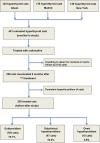
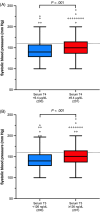

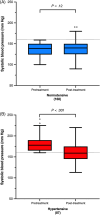


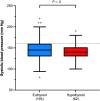
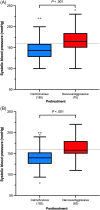
Similar articles
-
Survival of radioiodine treated hyperthyroid cats that are euthyroid and hypothyroid after treatment, and effect of levothyroxine supplementation on survival time of cats with iatrogenic hypothyroidism.J Vet Intern Med. 2025 Jan-Feb;39(1):e17295. doi: 10.1111/jvim.17295. J Vet Intern Med. 2025. PMID: 39831449 Free PMC article.
-
Urine concentrating ability in cats with hyperthyroidism: Influence of radioiodine treatment, masked azotemia, and iatrogenic hypothyroidism.J Vet Intern Med. 2023 Nov-Dec;37(6):2039-2051. doi: 10.1111/jvim.16849. Epub 2023 Sep 5. J Vet Intern Med. 2023. PMID: 37668163 Free PMC article.
-
Hyperthyroid cats that develop azotemia following successful radioiodine treatment have shorter survival times compared to cats that remain nonazotemic.J Am Vet Med Assoc. 2024 Dec 26;263(4):454-459. doi: 10.2460/javma.24.10.0653. Print 2025 Apr 1. J Am Vet Med Assoc. 2024. PMID: 39724773
-
Radioiodine treatment of hyperthyroidism.Clin Tech Small Anim Pract. 2006 Feb;21(1):34-9. doi: 10.1053/j.ctsap.2005.12.006. Clin Tech Small Anim Pract. 2006. PMID: 16584029 Review.
-
Hyperthyroid cats and their kidneys: a literature review.Aust Vet J. 2022 Sep;100(9):415-432. doi: 10.1111/avj.13179. Epub 2022 Jun 16. Aust Vet J. 2022. PMID: 35711100 Free PMC article. Review.
Cited by
-
Efficacy of Urine Asymmetric Dimethylarginine Concentration to Predict Azotemia in Hyperthyroid Cats After Radio-Iodine Treatment.J Vet Intern Med. 2025 May-Jun;39(3):e70096. doi: 10.1111/jvim.70096. J Vet Intern Med. 2025. PMID: 40271736 Free PMC article.
-
Survival of radioiodine treated hyperthyroid cats that are euthyroid and hypothyroid after treatment, and effect of levothyroxine supplementation on survival time of cats with iatrogenic hypothyroidism.J Vet Intern Med. 2025 Jan-Feb;39(1):e17295. doi: 10.1111/jvim.17295. J Vet Intern Med. 2025. PMID: 39831449 Free PMC article.
-
Systemic Arterial Hypertension and Factors Associated with Blood Pressure Dysregulation in Companion Animals.Vet Sci. 2025 May 9;12(5):453. doi: 10.3390/vetsci12050453. Vet Sci. 2025. PMID: 40431546 Free PMC article. Review.
References
-
- Stiles J, Polzin DJ, Bistner SI. The prevalence of retinopathy in cats with systemic hypertension and chronic renal failure or hyperthyroidism. J Am Anim Hosp Assoc. 1994;30:564‐572.
-
- Stepien RL, Rapoport GS, Henik RA, Sartor LL, Wenholz L. Effect of measurement method on blood pressure findings in cats before and after therapy for hyperthyroidism. J Vet Intern Med. 2003;17:754.
MeSH terms
LinkOut - more resources
Full Text Sources
Medical
Miscellaneous

